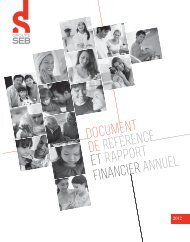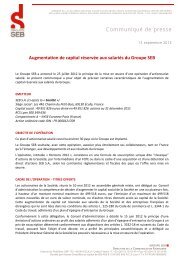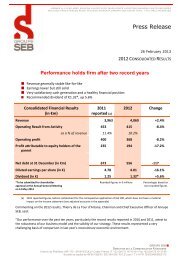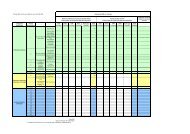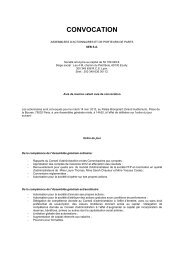Financial Report and Registration Document 2010 - Groupe Seb
Financial Report and Registration Document 2010 - Groupe Seb
Financial Report and Registration Document 2010 - Groupe Seb
Create successful ePaper yourself
Turn your PDF publications into a flip-book with our unique Google optimized e-Paper software.
2 CHAIRMAN’S<br />
CORPORATE GOVERNANCE<br />
REPORT ON INTERNAL CONTROL<br />
<strong>Document</strong>ation for this system includes reference to all procedures, tools<br />
<strong>and</strong> methods relating to the Group’s key processes:<br />
management procedures, definition of Group policy, strategic planning,<br />
constant improvement in quality, <strong>and</strong> safeguarding the environment;<br />
operational processes including strategic marketing, R&D, sales <strong>and</strong><br />
marketing, client order processing <strong>and</strong> production transfers;<br />
operational support functions, covering human resources, information<br />
systems, purchasing, finance, after-sales service <strong>and</strong> customer assistance.<br />
The Quality department uses monthly feedback reporting to fi ne-tune its<br />
action plans, which are then submitted to the Group Executive Committee.<br />
THE FINANCIAL COMMUNICATIONS DEPARTMENT<br />
Each year, this department draws up a schedule of the Group’s regular<br />
financial communications for financial markets <strong>and</strong> institutional investors. It<br />
identifies, in collaboration with the Legal department, legal <strong>and</strong> regulatory<br />
requirements for publication of Group financial notices.<br />
ACCOUNTING AND FINANCIAL INFORMATION PROCEDURES<br />
Internal control procedures for accounting <strong>and</strong> financial information aim to<br />
ensure the quality of the financial information provided by the consolidated<br />
subsidiaries, <strong>and</strong> the fairness <strong>and</strong> accuracy of the fi nancial information<br />
issued by the Group, while safeguarding against risks of error, inaccuracy<br />
or omission in the Group’s financial statements.<br />
<strong>Groupe</strong> SEB uses internal control guidelines based on AMF framework<br />
guidelines <strong>and</strong> accounting <strong>and</strong> financial audit principles.<br />
CENTRALIZED TREASURY AND FINANCE<br />
OPERATIONS<br />
Local regulations permitting, the Group Finance department ensures the<br />
financing of its subsidiaries via cash pooling, inter-company financing<br />
contracts <strong>and</strong> the use of currency flows for payments <strong>and</strong> receipts.<br />
This centralization of operations allows the Finance department to:<br />
control external debt <strong>and</strong> monitor its development;<br />
manage the risk rate inherent in the contracted debt;<br />
finance its subsidiaries in their local currency where regulations permit;<br />
anticipate <strong>and</strong> manage currency risk inherent in commercial <strong>and</strong> financial<br />
flows.<br />
Another important element of internal control is the Group’s centralized<br />
choice of working-partner banks <strong>and</strong> effective long-term management of<br />
these relations.<br />
This organization enables the Finance department to ensure overall control<br />
of the Group’s treasury operations.<br />
CONSOLIDATED ACCOUNTS MANAGEMENT<br />
AND CONTROL<br />
We have already described the role of Group Management Control in<br />
overseeing monthly consolidated financial management information.<br />
Budgetary control identifi es deviations from performance targets, on the<br />
basis of monthly consolidated data which is compared to an analysis of<br />
Group operational directives. This makes it possible to identify any changes<br />
or discrepancies in relation to financial budget data <strong>and</strong> previous years.<br />
This decentralized statutory consolidation includes all the companies in<br />
the Group that are directly or indirectly controlled by the Group’s holding<br />
company, SEB S.A.<br />
Each consolidated subsidiary prepares a set of accounts, restated to comply<br />
with the Group’s accounting procedures <strong>and</strong> based on accounting data from<br />
local information systems. All the Group’s entities apply IFR accounting<br />
st<strong>and</strong>ards.<br />
The Finance Managers of the subsidiaries prepare the restated accounts<br />
on the basis of the Group’s accounting procedures manual, which sets out<br />
rules for accounting entries <strong>and</strong> evaluation.<br />
This manual describes the principles used to draw up financial statements.<br />
The principles cover areas such as preparation of accounts on the<br />
assumption of operational continuity, compliance with accounting periods,<br />
<strong>and</strong> ensuring the integrity of the information in the fi nancial statements.<br />
It is regularly updated to integrate changes in legislation <strong>and</strong> regulations<br />
governing the preparation of consolidated accounts in France.<br />
The accounting procedures manual also gives a precise description of the<br />
principles used by the Group for accounting entries, <strong>and</strong> evaluation <strong>and</strong><br />
presentation of the main items in the financial statements:<br />
descriptions of constituent items of the consolidated income statement<br />
with their defi nitions, as well as consistency tests for the purpose of<br />
taxation;<br />
rules governing balance sheet <strong>and</strong> off-balance sheet items <strong>and</strong> their<br />
presentation;<br />
regulations concerning the valuation of certain estimated items, such as:<br />
provisions for the impairment of receivables,<br />
provisions for the impairment of stocks of raw materials <strong>and</strong> finished<br />
products,<br />
provisions for the impairment of non-current assets,<br />
provisions relating to sales (e.g., warranties <strong>and</strong> unsold returns),<br />
other provisions for risks <strong>and</strong> charges <strong>and</strong> in particular, provisions for<br />
restructuring;<br />
accounting principles applied to reporting intra-Group transactions.<br />
54 FINANCIAL REPORT AND REGISTRATION DOCUMENT <strong>2010</strong> GROUPE SEB



